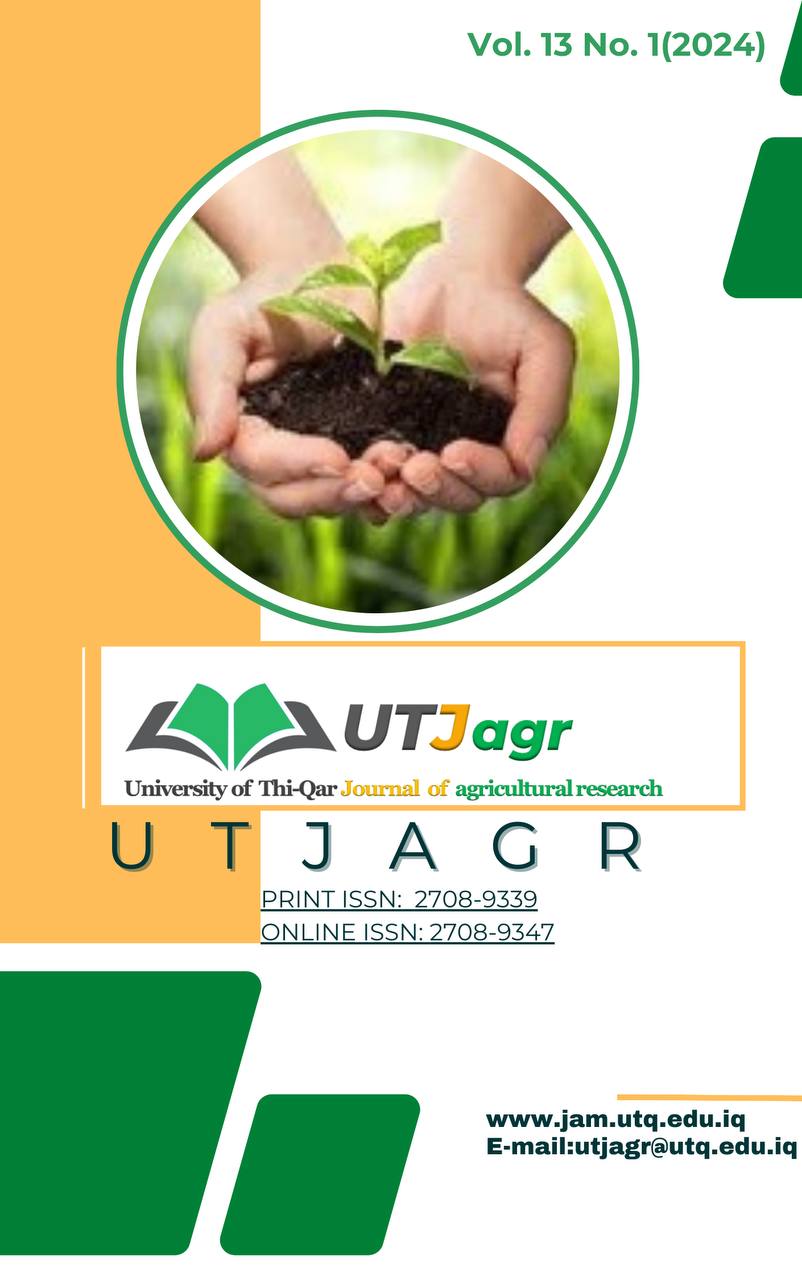THE INFLUENCE OF BIOMASS CONCENTRATION OF CYANOBACTERIA ON SHOOT MULTIPLICATION OF POTATO PLANT, DESIREE CULTIVAR, IN VITRO
DOI:
https://doi.org/10.54174/q6tgbb82Keywords:
Biomass, microtuber, Oscillatoria tenuis, rooting, stolon, tissue culture.Abstract
This study was conducted to determine the optimum concentration of the biomass of the cyanobacteria (Oscillatoria tenuis) which supports the MS medium prepared for shoot multiplication and rooting of potato plant Desiree cultivar from the culture of sprout explants via in vitro. The results showed that all concentrations of the cyanobacteria biomass extract + MS medium led to a 100% response to shoot formation after 60 days of culture. The 60% of the cyanobacteria biomass extract to the MS medium led to recording the largest number of shoots, reaching 8.8 shoots per explant, The 20% and 40% cyanobacteria biomass concentrations + MS medium treatments were significantly superior in average shoot length and number of leaves compared to the other two treatments, which amounted to 10.02 cm and 5.1 leaves per shoot and 10.48 cm and 5.0 leaves per shoot, respectively. The control treatment and the 20% cyanobacteria biomass concentration + MS Medium treatment did not produce any stolons from the shoots after 60 days of culture. The 40% and 60% cyanobacteria biomass concentration + MS medium treatments had stolons growing from the shoot site in contact with the nutrient medium. The stolon tips began to swell until microtubers were formed 60 days after culturing. The 60% cyanobacteria biomass concentration + MS Medium treatment was significantly superior in the average number of stolons, the number of microtubers, and the microtuber weight, which amounted to 4.6 stolons per shoot, 4.6 stolons per shoot, and 0.32g, respectively. The shoots were cultured in all treatments responded to rooting 60 days after culturing. The treatment 60% cyanobacteria biomass concentration + MS medium recorded the highest response to rooting of the shoots, the average number of roots, and root length which reached 100%, 5.8 roots per shoot, and. 6.2 cm, respectively.
Downloads
References
Abul-Soad AA, Jatoi MA. Factors affecting in vitro rooting of date palm (Phoenix dactylifera L.). Pak. J. Agri. Sci. 2014 Jun 1;51(2):467-74.
Al-Khazali, F. H. I. (2006). Producing seeds of the highest ranks of potatoes, Diamant, and Desiree cultivars, using different techniques. Doctoral Dissertation, University of Baghdad, Iraq.
Almusawi AH, Alshnawa AS, Alkhalifa AA, Almesfer RF. Induction of direct somatic embryogenesis in date palm (Phoenix dactylifera L.) cv. Hellawi. AAB Bioflux. 2015 Sep 1;7(2):80-9.
Al-Rawi KM., Khalafallah AM (2000). [Design and Analysis of Agricultural Experiments]. Dar Alkuteb for Press and Publishing, Mosul University, Iraq, 488 p. [In Arabic].
Banerjee M, Shrivastava S. An improved protocol for in vitro multiplication of Bacopa monnieri (L.). World Journal of Microbiology and Biotechnology. 2008 Aug;24:1355-9.
Chen Q, Su J, Nandy S, Kereliuk G. Screening potato genotypes for antioxidant capacity and total phenolics. InPlant Canada Congress 2007 (pp. 75-79).
Djurdjina, R., Milinkovic, M. and Miloševic, D. (1997). In vitro propagation of potato (Solanum tuberosum L.). Acta Horticulturae, 462, 959-964. https://doi.org/10.17660/ActaHortic.1997.462.152
Gupta AB, Agarwal PR. Extraction, isolation, and bioassay of a gibberellin-like substance from Phormidium foveolarum. Annals of Botany. 1973 Sep 1;37(4):737-41.
Hassan, A. A. (2003). Potatoes. Arab House for Publishing and Distribution, Cairo, Egypt.
Hegazy, A.E. (2014). Promising protocol for in vitro direct organogenesis of date palm cv. Ekhlass. Fifth International Date Palm Conference , Abu Dhabi - UAE; 16 – 18 March 2014.pp. 207-218.
Ibrahim MA, Waheed AM, Al-Taha HA. Plantlet regeneration from root segments of date palm tree (Phoenix dactylifera L. cv. Barhee) producing by in vitro culture. AAB Bioflux. 2013 May 1;5(1):45-50.
Kamarainen-Karppinen T, Virtanen E, Rokka VM, Pirttila AM. Novel bioreactor technology for mass propagation of potato microtubers. Plant Cell, Tissue and Organ Culture (PCTOC). 2010 May;101:245-9. https://doi.org/10.1007/s11240-010-9679-7
Keerthiga M, Anand SP, Nandagopalan V, Doss A, Senthilkumar SR. In vitro propagation of Wedelia trilobata (L.) using Phormidium subincrustatum extracts: A novel approach. Asia Pac. J. Mol. Biol. Biotechnol. 2012;20(4):147-52.
Koleva Gudeva L, Mitrev S, Trajkova F, Ilievski M. Micropropagation of Potato Solanum tuberosum L. Electronic Journal of Biology. 2012 Aug 15;8(3):45-9.
Mackinney G. Absorption of light by chlorophyll solutions. Journal of biological chemistry. 1941 Aug 1;140(2):315-22.
Mamiya K, Tanabe K, Onishi N. Production of potato (Solanum tuberosum, L.) microtubers using plastic culture bags. Plant biotechnology. 2020 Jun 25;37(2):233-8. https://doi.org/10.5511/plantbiotechnology.20.0312a
Mani F, Mhamdi M, Bettaieb T, Hannachi C. Shoot regeneration, micropropagation and microtuberization of potato (Solanum tuberosum L.) cultivars. Journal of new sciences. 2014 Jul 1.
Medina-Jaritz NB, Perez-Solis DR, Ruiloba de Leon SL, Olvera-Ramírez R. Antimicrobial activity of aqueous and methanolic extracts from Arthrospira maxima. Science against microbial pathogens: communicating current research and technological advances. A. Méndez-Vilas (Ed.). 2011:1267-71.
Mihaela C, Anca B, Andreea N, Monica P. Production of seedling tubers from true potato seed (TPS) in protected area. Journal of Horticulture, Forestry and Biotechnology. 2012;16(4):136-41.
Molnar Z, Ordog V. The effect of cyanobacterial compounds on the organogenesis of pea cultured in vitro. Acta Biologica Szegediensis. 2005 Jan 1;49(1-2):37-8.
Murashige T, Skoog F (1962). A revised medium for rapid growth and bio assays with tobacco tissue cultures. Physiologia Plantarum, 15(3): 473-497. https://doi.org/10.1111/j.1399-3054.1962.tb08052.x
Najjar KF. Commercialization of the patented microtuber multiplication system of potato. InThe second Arab conference on perspectives of modern biotechnology 1993 Apr (pp. 24-28).
Seema T, Arnold R, Tiwari A, Mishra RM, Chauhan UK. Cyanobacterial extract and MS media as a novel tool for in vitro regeneration of Stevia rebaudiana Bertoni. Journal of Algal Biomass Utilization. 2011;2(2):24-40.
Shar AH, Qambrani MA, Shar PA, Memon S, Shar AG, Liu J, Shen F, Kalhoro SA, Marri SN, Shahen M. Regeneration of Potato Plantlets Through Shoot Tip Culture Comparison Between GA3 and BAP. American Journal of Biology and Life Sciences. 2017;5(3):13-20.
Zaccaro MC, Kato A, Zulpa G, Storni MM, Steyerthal N, Lobasso K, Stella AM. Bioactivity of Scytonema hofmanni (Cyanobacteria) in Lilium alexandrae in vitro propagation. Electronic Journal of Biotechnology. 2006 Jun;9(3):0-.
Zamotaeva G., 1997 [Potato Production Guide]. Agropromizdat Publishing House, Moscow, 348 pp. [In Russian].

Downloads
Published
Issue
Section
License

This work is licensed under a Creative Commons Attribution-NonCommercial-ShareAlike 4.0 International License.







1.png)

